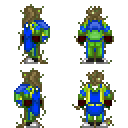Diona
- No special features.
- Light provides nutrition in addition to constant healing when not in crit.
- Starves in darkness.
- +50% heat damage.
- +25% damage from overheating.
- Takes extra damage from atrazine/glyphosate.
- Takes extra damage from the Chef's pet Goat
The Dionae are a race of plant-like beings with gestalt consciousness, composed of many smaller Nymphs. Their world of origin is unknown.
Dionae and YOU
Greetings, esteemed crewmember!
In an effort to encourage inter-species cooperation and workplace efficiency, NanoTrasen has compiled a series of helpful guides on the various species that you may be working with!
(NOTE: If you are a member of the species this guide pertains to, please give it to the nearest crewmember of another species)
This particular guide refers to the species known as the Dionae (singular: Diona).
Diona Naming Schemes
Dionae do not have names as such, though will adopt individual identifiers when required by their environment. Usually they supply an often long and poetic description of a memory they consider fundamental to their makeup: for instance, 'the glitter of starlight across the face of the iron mountain and the deep note of the planet-song'. However, due to their noted pattern of mimicry and adaptation, more conventional (if unusual) names are not uncommon.
Diona Physiology
Dionae are highly unusual amongst most organisms in that they appear to be entirely made out of plant matter. While the name “Diona” is usually used to refer to the humanoid representatives of the species, a single member of the family is technically a diona nymph - a rather small, insect-like being. The nymphs have the ability to join themselves into a larger structure - a gestalt. A gestalt can usually be treated as a single being due to the diona nymphs merging their consciousness with the larger structure, but it’s possible for a nymph to be a part of a gestalt and still retain its agency. The causes of such inconsistent behaviour are not yet known, but likely stem from simple genetic defects of the nymphs.
Gestalts have the ability to grow the equivalent of a circulatory system, necessary to enable the transfer throughout their ‘body’ of a green substance known as chlorophyll which is vital to allow energy to reach parts that are not directly exposed to a light source. Additionally, until Diona reach a large enough size they are unable to safely spend time in the vacuum of space as their fragile branches are prone to breaking, and their small mass requires they gain oxygen from external sources - as a result often being found on space stations or oxygen rich planets.
A single gestalt can range in size from a small clump of a few nymphs to a large station-size structure, the largest of which are sometimes referred to as “reefs”. Once they have grown enough to equal the size of a standard crew escape shuttle they are able to subsist exclusively off interplanetary dust and the light from stars, however in order for a gestalt to be able to serve in Nanotrasen facilities, it must be able to function as the rest of the crew and as such, a humanoid shape involving a head and a set of limbs is expected.
The Rootsong Language
Dionae possess a mysterious inborn language, which is referred to as “Rootsong” in Galactic Common. They all appear to understand it innately, though its precise rules and mechanisms are difficult to decipher. It seems to operate via oscillating signals on any available kind of wave, whether sound waves for nymphs and crew-sized dionae or microwave transmissions for the larger gestalts. A majority also seem to refer to themselves plurally (we, our, etc.) somewhat referencing their physical makeup.
Curiously, Diona are able to readily acquire the languages of other races via a fascinating biological mechanism. As nymphs, they often steal tiny amounts of blood from members of other species, and in doing so acquire knowledge including language and general cultural background. It is believed that during this, their feelers briefly interface with the donor’s nervous system in the same way they would with that of another nymph when forming a gestalt, allowing them to take a "snapshot" of synaptic activity. While the precise nature of this process is still unknown, it is a matter of no small scientific interest. Crew members are advised that diona nymphs may do this without warning, but also that the process is entirely benign. The amount of blood taken is medically insignificant, and the process has not been noted to have any long-term effects on the subjects.
The Diona Homeworld?
It is unknown if Dionae even have a homeworld, as all known interactions with the race have taken place on planets with other populations such as the Kidan homeworld, or inside massive, moon-sized structures scattered all around the galaxy that are believed to be made up of giant Diona that are so ancient they have become capable of housing their own self sufficient atmosphere and ecosystem where the younger of the species are able to grow and thrive. The diona themselves appear to be unaware of how they have spread so far, however have remained consistently adamant on certain things; the planetoids that keep them safe are highly revered, alive, and protective of its charges. More scientific investigations have largely concurred that their spread happens naturally as the gestalt gains enough size and mass. A population from the Kidan homeworld of Aurum was discovered concurrently with the Kidan, but the Dionae were known to the Skrell (and possibly others) long before this.(For more information on the Dionae of Aurum, see Kidan History)
A Brief History 

|
| Unknown |
The earliest record of the Diona appears in 2204, when Skrellian exploratory craft came across the system known to human astronomers as Epsilon Ursae Minoris during a scouting expedition. They dutifully flagged it for review, as it was a ternary system with a triad of stars, and went on their way, noting a few strange readings from the outer coronae of the system's core bodies.
Only when the mining fleets of a Skrell industrial consortium arrived in 2234 did the readings become explained. A large sphere- a deep mossy green- was orbiting a planet along with three other moons. As they neared, the ships received a directed signal from the structure which had the scientists aboard frenzied with excitement: Something was there and very pleased to meet them.
Over the next several years, further science vessels were brought in and the strange electromagnetic language of the creatures that came to be called Dionae was painstakingly decrypted. The scientists learned that the strange, immense structures were societies of plantlike creatures, and the mass- the name of which was translated to the Galactic common equivalent of “Topiary” was not only filled with hundreds if not thousands of diona, but the structure itself was alive; fuelled by hard radiation, asteroid impacts and a complex interactions with the superheated gas they gathered from the stars’ coronae.
Eventually, over several months (due to the collective, diplomatic nature of the residing Dionae) an agreement was reached. The scientists would take both varying samples and seeds to sow on other planets and star systems and allow safe passage and work opportunities for the excited and adventurous of the species. In exchange, the colony would allow the surveyors and miners to visit and trade freely, in addition to permission to harvest the materials from stellar ejecta and asteroids that had collected on the surface over the eons.
Currently Dionae can be found in almost all corners of the known galaxy primarily within their moon-like colonies, though can often be found living amongst other races on stations, ships and even planets. Contact between increasing numbers of curious spacefarers and explorers has resulted in many similar exchanges, speeding their dispersal.
Diona Culture
Diona culture does not fit in how many would consider it defined, those that travel with other races commonly adopting many of the customs and ideas from those they become closest to, while those who remain within their “topiary” moons remain largely, though loosely connected to their ancient ancestor that houses them. The nymphs and humanoid-sized Dionae encountered by crew members consequently seem rather individualistic, at least until their life cycle leads them to eventually merge with a larger body. However, as with most species, these individuals can vary wildly, especially due to the mixing of traits from those they mimic or absorb from, despite their common beginnings and eventual endings. Many prefer lives with minimal advanced or computerised technology, while just as openly seek out items they can build or gain from trade with outside sources; their only universal interest seems to be the accumulation of knowledge and the spread of their species.
Religion is rare among the Dionae, most of them not paying attention to metaphysical matters at all, as the species, thanks to its biology, rarely faces death.
Present Day
While widely dispersed, and perhaps possessing vast knowledge of science and the history of the Galaxy, the Dionae cannot be considered major galactic actors as they do not act as a group. They seem content to live symbiotically with the various spacefaring peoples, and do not seem interested in involving themselves with galactic affairs, aside from certain rare individuals. They are known to be generally friendly, the residents from the topiary moons showing a fondness for sheltering distressed ships, but they seldom act politically.
However, Dionae do have a subtle yet significant economic influence. They have proved invaluable to the ecology of spacecraft all over the galaxy, their nymphs protecting hydroponic food supplies from pests, improving the growth of other plants, or even serving as an adequate food source themselves. Occasionally these nymphs can grow into crew-sized gestalts and prove even more useful. This has been the main means for their recent spread through the Galaxy.
Due to these several services they can provide, you can find many representatives of the species onboard Nanotrasen vessels. You may even find a gestalt as your supervisor, thanks to our foreign species involvement programs.
Remember, crewmember, mutual respect and cooperation are the cornerstones of success and productivity!














